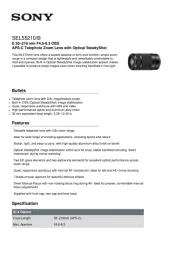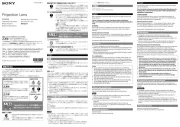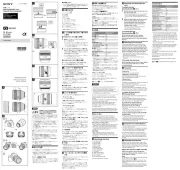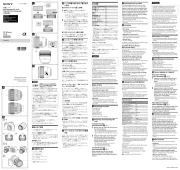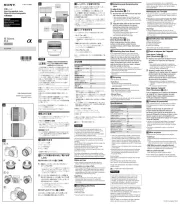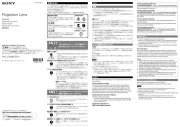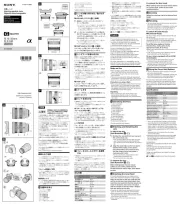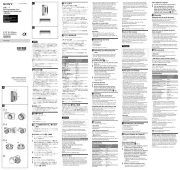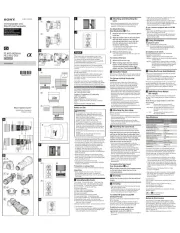
この取扱説明書には、事故を防ぐための重要な注意事項と製品
の取り扱いかたを示しています。この取扱説明書をよくお読み
の上、製品を安全にお使いください。お読みになったあとは、い
https://www.sony.jp/support/ichigan/
• レンズを絶対に太陽や強い光源に向けたままにしないで
ください。レンズの集光作用により、発煙や火災、ボディ・
レンズ内部の故障の原因になります。やむを得ず太陽光
下等におく場合は、前後レンズキャップを取り付けてく
ださい。逆光撮影時は、太陽を画角から充分にずらして
•本機は防じん、防滴性に配慮して設計されていますが、防
水性能は備えていません。雨中使用時などは、水滴がか
• レンズ単体の状態や、カメラ装着時に電源を切った状態
で本機を振ると、内部構造物が動き、音が発生することが
なお、本機を持ち運ぶ際などの振動で内部のレンズ群が
•繰り出されたレンズ部分でカメラを保持しないでくださ
• レンズを取り付けてカメラを持ち運ぶときは、カメラと
•本機を他社製品と組み合わせて使用した際の性能や、そ
れによって生じた事故、故障につきましては保証いたし
• レンズとフラッシュの組み合わせによっては、レンズが
フラッシュ光を妨げ、写真の下部に影ができることがあ
ります。その場合は、焦点距離または撮影距離を調整し
• レンズは原理的に画面周辺部の光量が中心部に比べ低下
します。周辺光量の低下が気になる場合は、開放絞りか
• レンズの取り付け/取りはずしは、レンズのマウント側
を持って行ってください。フォーカスリングなどの操作
•レンズを取り付けるときは、カメラのレンズ取りは
•レンズフロントキャップは図の(1)、(2)の2通りの方
• レンズフードを「カチッ」というまで回さないと、撮影画
像に影ができたり、フードが落下したりする恐れがあり
• フラッシュ光が遮られて、写真の下部に影ができることが
あります。その場合はレンズフードをはずしてください。
•撮影後レンズフードを収納するときは、逆向きにレンズ
•本製品のフォーカスモードスイッチは、一部のカメラ本
カメラ本体との互換情報については専用サポートサイト
AF(オートフォーカス:自動ピント合わせ)/ MF(マ
ニュアルフォーカス:手動によるピント合わせ)の設定
AFで撮影する場合は、カメラ側とレンズ側両方の設定
をAFにします。カメラ側あるいはレンズ側のいずれか
一方、または両方の設定がMFの場合、MFになります。
• カメラのフォーカスモードの設定方法については、カメ
• MFではファインダー等を見ながらフォーカスリングを
• AF動作時にAF/MFボタンを押すと、一時的にMFへ切り
• MF動作時にAF/MFボタンで一時的にAFへ切り替えがで
きるのは、レンズの設定がAF、カメラの設定がMFの場合
•本製品のフォーカスホールドボタンは、一部のカメラ本
カメラ本体との互換情報については専用サポートサイト
AF中にフォーカスホールドボタンを押すと、AFの駆
絞り指標に絞り目盛「A」を合わせると、オートアイリス
また、絞りリングを回すことで、光量をF4 ~F22にマ
絞りリングを絞り目盛の「A」で固定する、またはF4 ~
F22の間でのみ動かすときは、IRISLOCKスイッチを
解除するには、IRISLOCKスイッチを マークと反対
グクリック切り替えスイッチを「OFF」にしてくださ
絞りリングクリック切り替えスイッチが「OFF」のとき
絞りリングクリック切り替えスイッチを「ON」にした
オートフォーカス時 0.3 (W)-0.25 (T)
撮像素子がAPS-Cサイズ相当のレンズ交換式デジタル
画角1は35mm判カメラ、画角2はAPS-Cサイズ相当の撮
最短撮影距離とは、撮像素子面から被写体までの距離を
• レンズの機構によっては、撮影距離の変化に伴って焦点
距離が変化する場合があります。記載の焦点距離は撮影
ます。当該ソフトウェアの著作権者様の要求に基づき、
https://rd1.sony.net/help/di/lens_oss1/en/
This instruction manual explains how to use
lenses. Precautions common to all lenses such
as notes on use are found in the separate
“Precautions before using”. Be sure to read both
documents before using your lens.
This lens is designed for Sony α camera system
E-mount cameras. You cannot use it on A-mount
The lens is compatible with the range of a 35mm
A camera equipped with a 35mm format image
sensor can also be set to shoot at APS-C size.
For details on how to set your camera, refer to its
For further information on compatibility, visit the
web site of Sony in your area, or consult your dealer
of Sony or local authorized service facility of Sony.
For Customers in the U.S.A.
For question regarding your product or for the Sony
Service Center nearest you,
call 1-800-222-SONY (7669).
Supplier’s Declaration of Conformity
Responsible Party : Sony Electronics Inc.
Address : 16535 Via Esprillo, San Diego, CA 92127
Telephone Number : 858-942-2230
• Do not leave the lens exposed to the sun or a bright
light source. Internal malfunction of the camera
body and lens, smoke, or a fire may result due to the
effect of light focusing. If circumstances necessitate
leaving the lens in sunlight, be sure to attach the lens
caps. When shooting against the sun, keep the sun
completely out of the angle of view.
• This lens is not water-proof, although designed with
dust-proofness and splash-proofness in mind. If using
in the rain etc., keep water drops away from the lens.
• If the lens alone is shaken or if a camera with the lens
attached is shaken while the camera is turned off,
an internal component of the lens may rattle. This,
however, does not indicate a malfunction.
In addition, while you carry around the lens, your
movement may cause the internal lens groups to
shake. This, however, does not affect the performance
• Do not hold the lens by its extended part.
• When carrying a camera with the lens attached,
always firmly hold both the camera and the lens.
• Using this unit with products from other
manufacturers may affect its performance, leading to
accidents or malfunction.
Precautions on using a flash
• With certain combinations of lens and flash, the lens
may partially block the light of the flash, resulting in
a shadow at the bottom of the picture. In such a case,
adjust the focal length or the shooting distance before
• When using the lens, the corners of the screen
become darker than the center. To reduce this
phenomena (called vignetting), close the aperture by
15 Lens mount rubber ring
Do not touch the lens contacts.
Attaching and Detaching the
• Before attaching/detaching the lens, hold the lens
by its mounting body. Do not hold it by any of its
operation controls, such as the focusing ring.
Remove the rear lens cap and the camera
Align the white index on the lens barrel
with the white index on the camera
(mounting index), then insert the lens
into the camera mount and rotate it
clockwise until it locks.
• Do not press the lens release button on the
camera when mounting the lens.
• Do not mount the lens at an angle.
Remove the front lens cap.
• You can attach/detach the front lens cap in two
Attach the front lens cap.
While holding down the lens release
button on the camera, rotate the lens
counterclockwise until it stops, then
detach the lens. (See illustration
It is recommended that you use a lens hood to
reduce flare and ensure maximum image quality.
Align the red line on the lens hood with the
red line on the lens (lens hood index), then
insert the lens hood into the lens mount and
rotate it clockwise until it clicks into place
and the red dot on the lens hood is aligned
with the red line on the lens.
• If the lens hood is not rotated until it clicks into
place, there is a possibility that a shadow appears on
captured images or the lens hood falls off.
• If the flash light is partially blocked by the lens hood,
a shadow may appear at the bottom of captured
images. In such a case, remove the lens hood.
• When storing, fit the lens hood onto the lens
Rotate the zooming ring to the desired focal
• The focus mode switch of this lens does not function
For further information on compatibility, visit the web
site of Sony in your area, or consult your dealer of
Sony or local authorized service facility of Sony.
To switch AF (auto focus)/
The focus mode can be switched between AF and
For AF photography, both the camera and lens
should be set to AF. For MF photography, either or
both the camera or lens should be set to MF.
To set the focus mode on the lens
Slide the focus mode switch to the
appropriate mode, AF or MF (1).
• Refer to the camera manuals to set the focus mode of
• In MF, turn the focusing ring to adjust the focus (2)
while looking through the viewfinder, etc.
To use a camera equipped with an AF/MF
• By pressing the AF/MF button during AF operation,
you can temporarily switch to MF.
• Pressing the AF/MF button during MF operation lets
you temporarily switch to AF if the lens is set to AF
Using the Focus Hold Button(s)
• The focus hold button of this lens does not function
For further information on compatibility, visit the web
site of Sony in your area, or consult your dealer of
Sony or local authorized service facility of Sony.
Press the focus hold button in AF to cancel AF. The
focus is fixed and you can release the shutter on
the fixed focus. Release the focus hold button while
pressing the shutter button halfway to start AF
When you align “A” on the aperture scale to the
aperture index, the camera is set to auto iris mode
and the exposure is set by the camera. And you can
adjust the amount of light manually between f/4
and f/22 by rotating the aperture ring.
To lock the aperture ring at “A” on the aperture scale
or limit the turning of the aperture ring within the
range from f/4 to f/22 on the aperture scale, slide
the IRIS LOCK switch toward the
To unlock the aperture ring or the limitation, slide
the IRIS LOCK switch away from the mark.
Set the aperture click switch to “OFF” when shooting
movies. (See illustration
When the aperture click switch is set to “OFF,” the
sound of the aperture ring is reduced. (For movie
If you change the aperture value while shooting a
movie with the aperture click switch set to “ON,” the
sound of the aperture ring will be recorded.
Lens groups-elements 13-16
Auto focus 0.3 (W)-0.25 (T)
Maximum magnification (X) 0.39
Mass (approx., g (oz)) 488 (17.3)
This is the equivalent focal length in 35mm format
when mounted on an Interchangeable Lens Digital
Camera equipped with an APS-C sized image sensor.
Angle of view 1 is the value for 35mm cameras, and
angle of view 2 is the value for Interchangeable Lens
Digital Cameras equipped with an APS-C sized image
Minimum focus is the distance from the image
• Depending on the lens mechanism, the focal length
may change with any change in shooting distance.
The focal lengths given above assume the lens is
(The number in parentheses indicates the number
Lens (1), Front lens cap (1), Rear lens cap (1),
Lens hood (1), Lens case (1),
Set of printed documentation
Design and specifications are subject to change
This product comes with software that is used
based on licensing agreements with the owners
of that software. Based on requests by the owners
of copyright of these software applications, we
have an obligation to inform you of contents of the
agreement. For the software used on this product,
https://rd1.sony.net/help/di/lens_oss1/en/
Cette notice explique comment se servir des
objectifs. Les précautions communes à tous
les objectifs, par exemple les remarques sur
l’emploi, se trouvent sur la feuille « Précautions
avant toute utilisation ». Veuillez lire les deux
documents avant d’utiliser votre objectif.
Votre objectif est conçu pour les appareils photo à
monture E de type Sony α. Il ne peut pas être utilisé
pour les appareils photo pourvus d’une monture A.
L’objectif est compatible avec la plage des capteurs
Un appareil photo équipé d’un capteur d’image de
format 35mm peut être réglé pour la prise de vue
Pour les détails sur la manière de régler l’appareil
photo, reportez-vous à son mode d’emploi.
Pour plus d’informations sur la compatibilité,
consultez le site de Sony de votre pays, ou adressez-
vous à un revendeur Sony ou à un service après-
• Ne laissez pas la lentille orientée vers le soleil ou une
source de lumière intense. Cela risque de provoquer
un problème de fonctionnement interne du boîtier
de l’appareil photo et de l’objectif, de dégager de la
fumée, voire de provoquer un incendie. Si toutefois
vous ne pouvez pas faire autrement, veillez à fixer les
capuchons sur l’objectif. Lors d’une prise de vue en
direction du soleil, veillez à ce que le soleil ne soit pas
• Cet objectif n’est pas étanche à l’eau bien qu’il
soit conçu pour résister à la poussière et aux
éclaboussures. Si vous l’utilisez sous la pluie, etc.
veillez à ce que de l’eau ne tombe pas dessus.
• Lorsque l'objectif seul est secoué ou lorsqu'un
appareil photo hors tension sur lequel est fixé
l'objectif est secoué, un composant interne de
l'objectif peut faire du bruit. Toufefois, ce phénomène
n’indique en aucune manière un dysfonctionnement.
En outre, lors du transport de l'objectif, votre
mouvement peut provoquer la vibration des groupes
de lentilles internes. Ceci n'influe toutefois pas sur les
performances des groupes de lentilles.
• Ne tenez pas l’objectif par sa partie déployée.
• Lorsque vous portez un appareil photo avec l’objectif
dessus, tenez toujours fermement l’appareil photo et
• L’utilisation de cet appareil avec des produits d’autres
fabricants risque de nuire à ses performances,
entraînant des accidents ou des dysfonctionnements.
Précautions concernant l’emploi d’un flash
• Associé à certains types de flash, l’objectif peut
bloquer partiellement la lumière du flash et produire
un ombre au bas de l’image. Dans ce cas, corrigez la
longueur focale ou la distance de prise de vue avant
• Lorsque l’objectif est utilisé, les coins de l’écran
deviennent plus sombres que le centre. Pour réduire
ce phénomène (appelé vignetage), fermez l’ouverture
Identification des éléments
4 Bouton de maintien de la mise au point
12 Commutateur de mode de mise au point
15 Bague en caoutchouc de montage de l’objectif
16 Commutateur d’encliquetage de l’ouverture
Ne touchez pas les contacts d’objectif.
Pose et dépose de l’objectif
• Avant de poser ou de déposer l'objectif, tenez-le
par sa monture. Ne le tenez pas par ses pièces de
fonctionnement, telles que la bague de mise au point.
Déposez le capuchon d'objectif arrière et
le capuchon de l'appareil photo.
Alignez le repère blanc du barillet
d’objectif sur le repère blanc de l’appareil
photo (repère de montage), puis posez
l’objectif sur la monture de l’appareil
photo et tournez-le dans le sens horaire
de sorte qu’il s’encliquette.
• N’appuyez pas sur le bouton de libération de
l’objectif sur l’appareil photo lorsque vous posez
• Ne posez pas l’objectif de biais.
Retirez le capuchon d'objectif avant.
• Vous pouvez poser et déposer les capuchons
d’objectif avant de deux façons, (1) et (2).
Installez le capuchon d'objectif avant.
Tout en appuyant sur le bouton de
libération de l’objectif sur l’appareil
photo, tournez l’objectif dans le sens
antihoraire jusqu’à l’arrêt, puis déposez
l’objectif. (Voir l’illustration
Il est conseillé d’utiliser un pare-soleil pour réduire
la lumière parasite et obtenir la meilleure image
Alignez la ligne rouge du pare-soleil sur la
ligne rouge de l’objectif (repère de pare-
soleil), puis insérez le pare-soleil sur la
monture d’objectif et tournez-le dans le
sens horaire jusqu’à ce qu’il s’encliquette
et le point rouge du pare-soleil s’aligne sur
la ligne rouge de l’objectif (repère de pare-
• Si le pare-soleil n’est pas tourné à fond jusqu’à
entendre un clic, de l’ombre peut apparaître sur les
photos prises ou le pare-soleil peut tomber.
• Si l’éclair du flash est partiellement bloqué par le
pare-soleil, de l’ombre peut apparaître au bas des
photos prises. Dans ce cas, retirez le pare-soleil.
• Pour ranger le pare-soleil, insérez-le à l'envers dans
Tournez la bague de zoom selon la focale
• Le commutateur de mode de mise au point de cet
objectif ne fonctionne pas sur certains modèles
Pour plus d’informations sur la compatibilité,
consultez le site de Sony de votre pays, ou adressez-
vous à un revendeur Sony ou à un service après-vente
Pour commuter entre AF (mise au
point automatique) et MF (mise au
Il est possible de régler le mode de mise au point
sur AF ou MF sur l’objectif.
Pour la photographie en mode AF, l’appareil photo
et l’objectif doivent être tous les deux réglés sur AF.
Pour la photographie en mode MF, l’appareil photo
ou l’objectif, ou bien les deux, doivent être réglés
Pour régler le mode de mise au point sur
Réglez le commutateur de mode de mise au
point sur le mode adapté, AF ou MF (1).
• Reportez-vous aux manuels de l’appareil photo pour
régler le mode de mise au point sur l’appareil photo.
• En mode MF, tournez la bague de mise au point pour
faire la mise au point (2) tout en regardant dans le
Pour utiliser un appareil photo pourvu
• En appuyant sur la touche AF/MF en mode AF, vous
pouvez provisoirement passer en mode MF.
• En appuyant sur la touche AF/MF en mode MF, vous
pouvez provisoirement passer en mode AF si l’appareil
photo est réglé sur MF et l’objectif sur AF.
(Suite à la page arrière)
